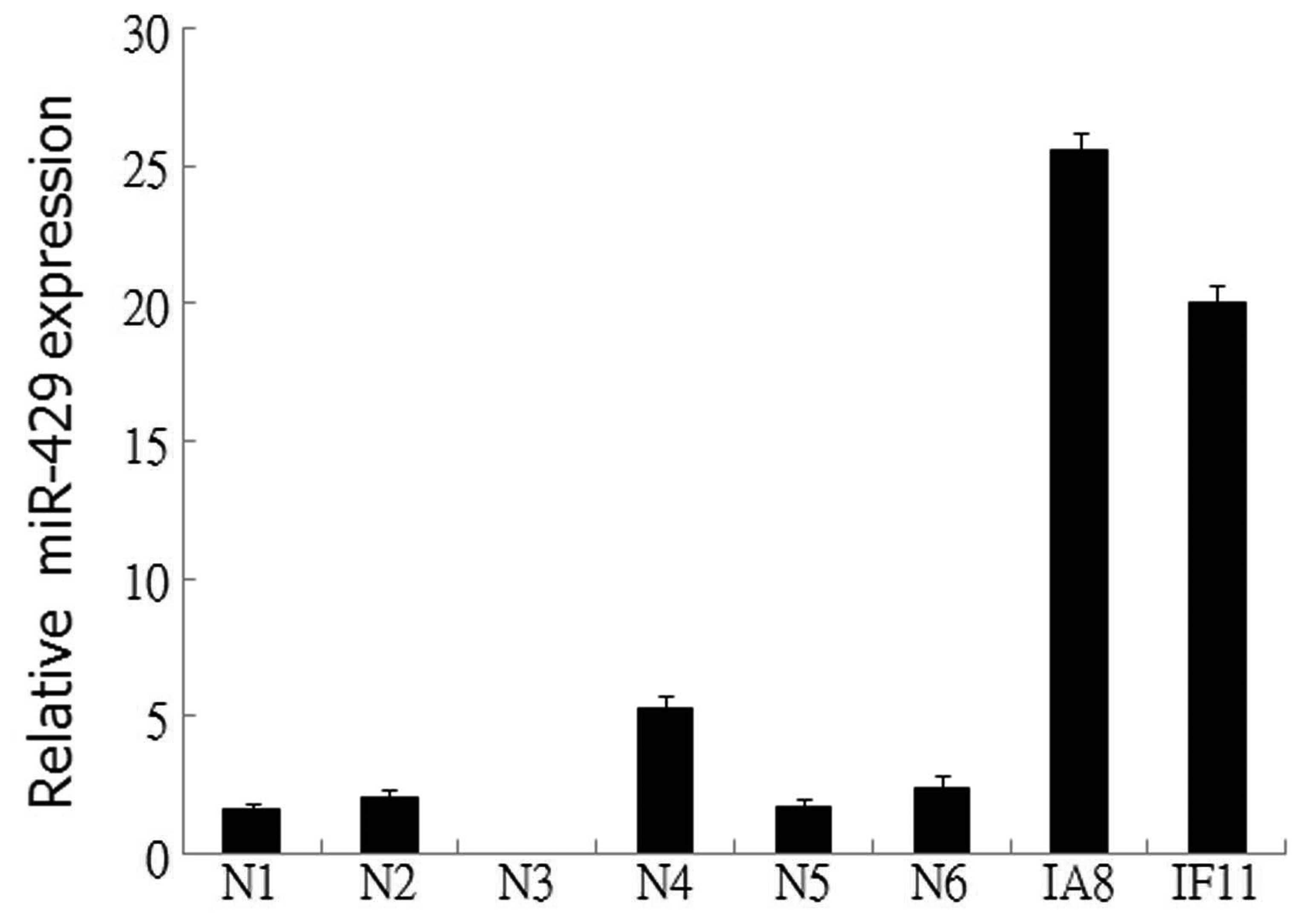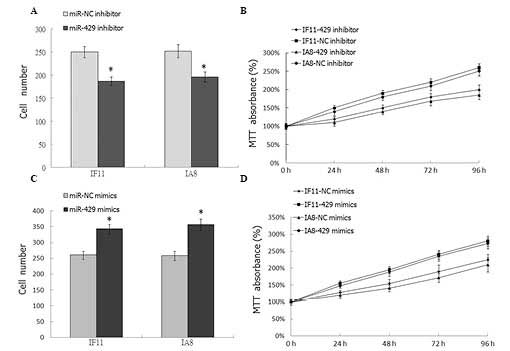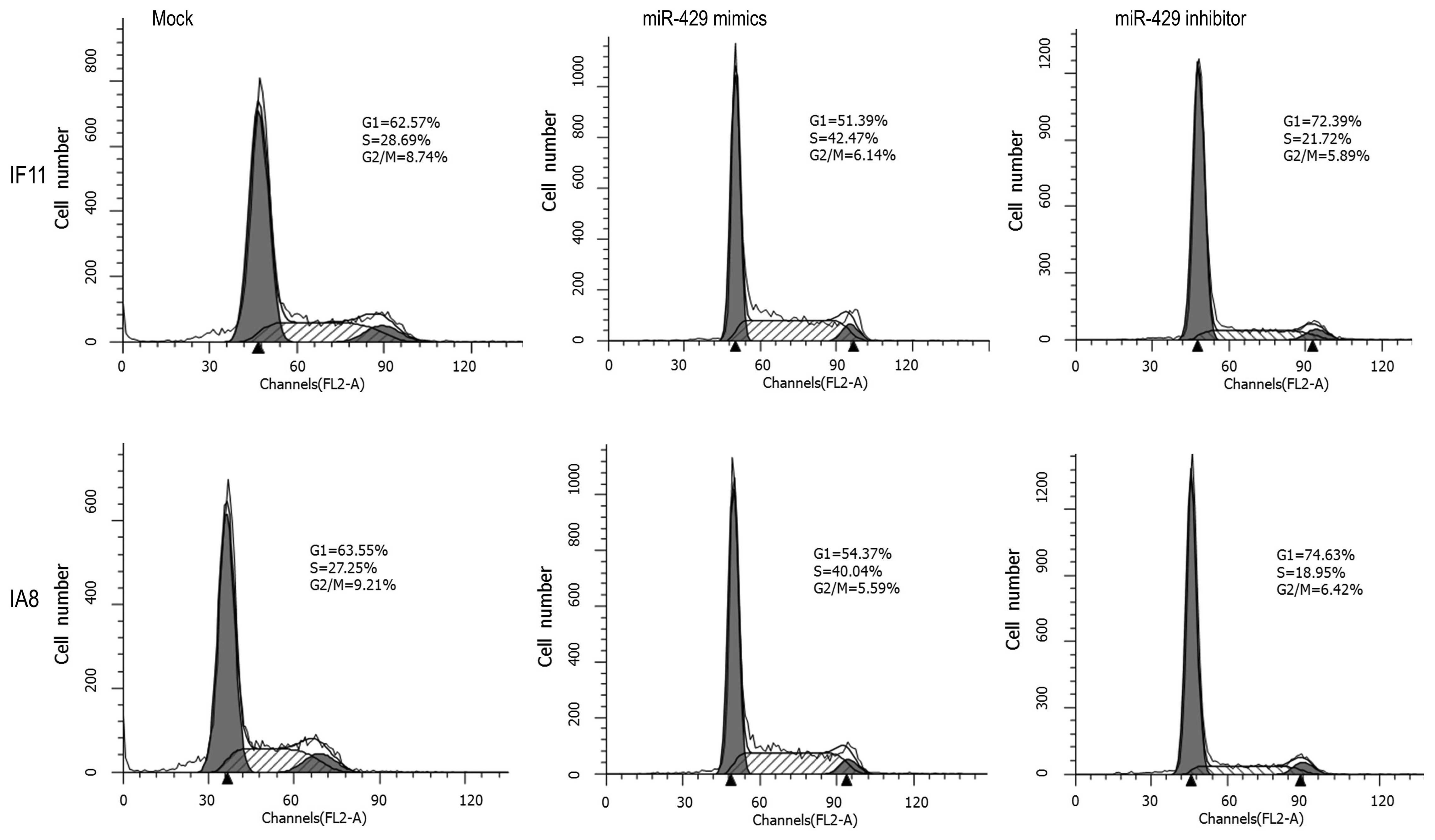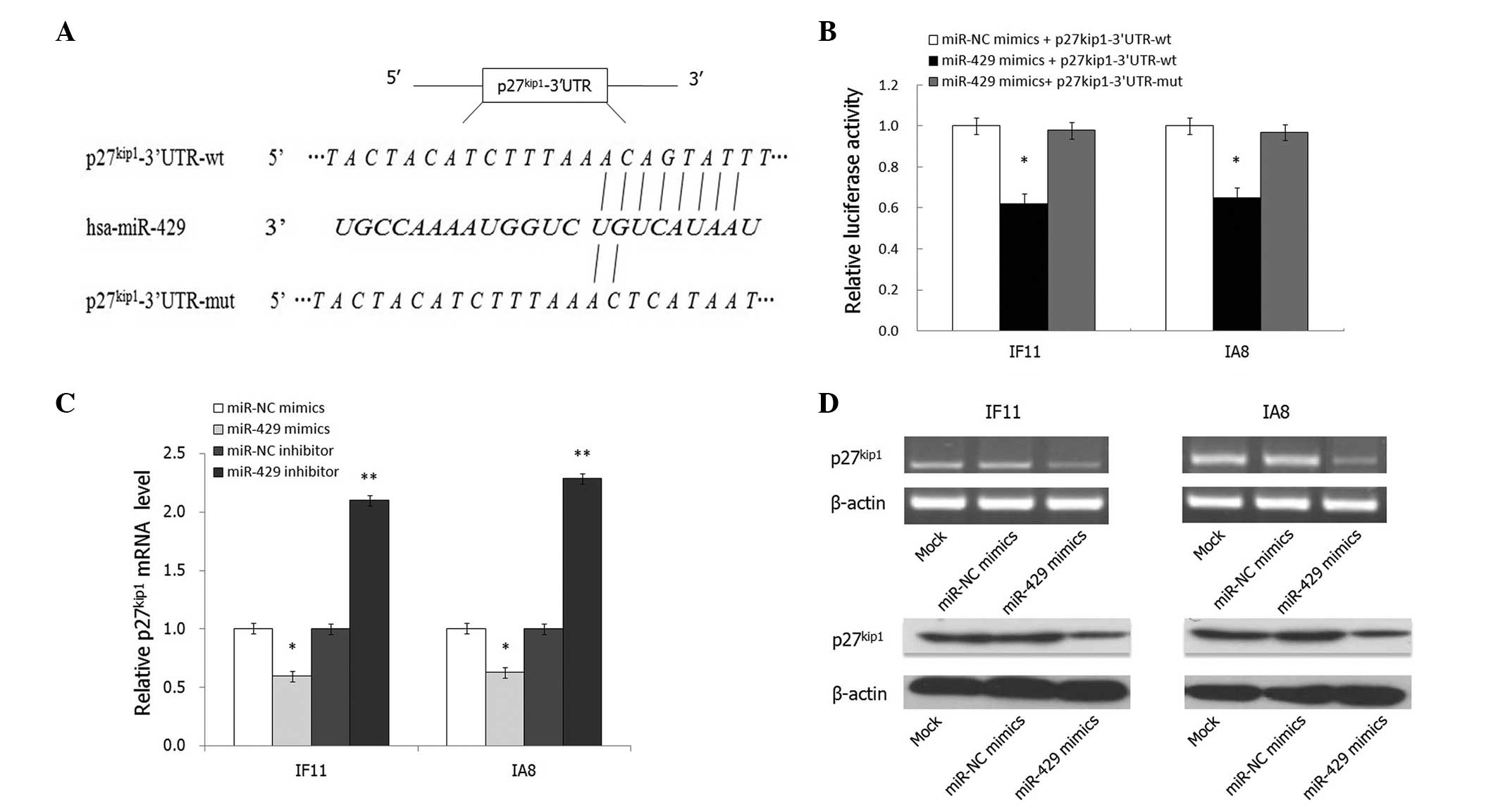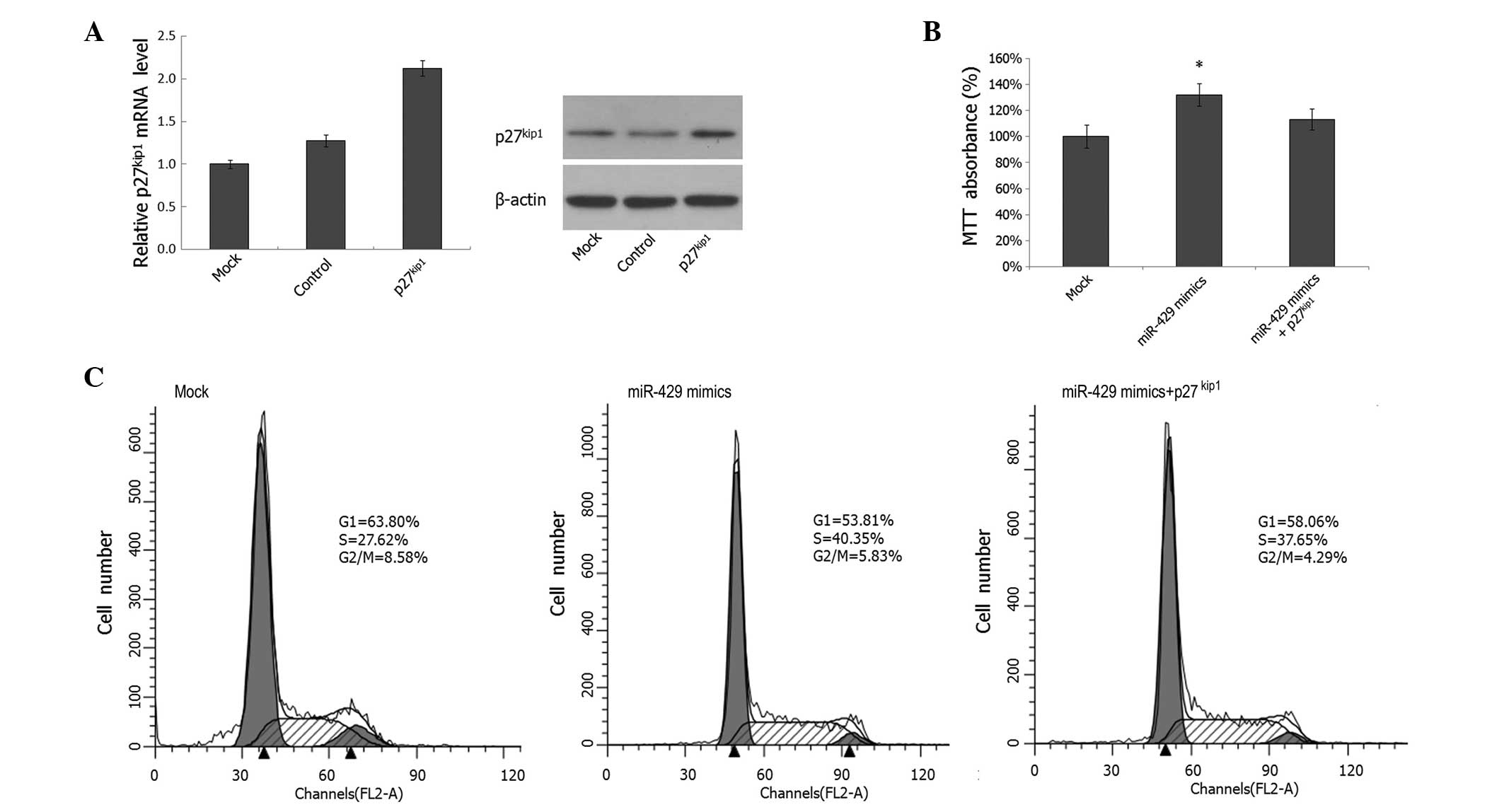Downregulation of microRNA-429 inhibits cell proliferation by targeting p27Kip1 in human prostate cancer cells
- Authors:
- Published online on: October 27, 2014 https://doi.org/10.3892/mmr.2014.2782
- Pages: 1435-1441
Abstract
Introduction
Prostate cancer has the second highest cancer-related mortality rate in males (1). In the early stages of the disease, the most effective treatment is surgical castration and hormonal manipulation using gonadotropin-releasing hormone agonists or androgen receptor antagonists. However, numerous prostate cancer patients eventually experience recurrence and androgen independence, which commonly results in accelerated disease progression and fatality (2,3). Thus, novel molecular targets for effective prostate cancer treatment strategies and chemopreventative interventions are urgently required.
MicroRNAs (miRNAs) are a novel class of endogenous, small, non-coding, single-stranded RNAs that regulate gene expression at the post-transcriptional level by targeting the 3′ untranslated region (3′UTR) of target mRNAs (4–7). miRNAs have been implicated in a wide range of physiological processes, including cell proliferation, apoptosis and cell differentiation (8,9). Aberrant miRNA expression has been demonstrated to be correlated with cell proliferation, invasion, metastasis and prognosis in various types of cancer, including prostate cancer (10,11). miR-429, a member of the miR-200 miRNA family, has been shown to be downregulated in gastric carcinoma and may act as a tumor suppressor by targeting c-myc (12). Other studies have reported that miR-429 is upregulated in bladder and endometrial carcinoma (13,14). In addition, higher expression levels of miR-429 have been correlated with poor prognosis in patients with serous ovarian carcinoma (15). These results suggest that miR-429 is correlated with tumorigenesis and may exert different effects in distinct types of cancer. Whether miR-429 is involved in the genesis and development of prostate cancer remains to be elucidated.
In the present study, the expression levels of miR-429 in two prostate cancer cell lines and six normal prostate epithelial tissues were analyzed in order to explore the function of miR-429 in the oncogenesis of prostate cancer.
Materials and methods
Cell culture
The IF11 and IA8 human prostate cancer cell lines (American Type Culture Collection, Manassas, VA, USA) were cultured in RPMI 1640 medium (Invitrogen, Carlsbad, CA, USA) supplemented with 10% fetal bovine serum (Invitrogen), 100 U/ml penicillin and 100 μg/ml streptomycin (Shanghai Genebase Gen-Tech Co., Ltd., Shanghai, China) at 37°C in a 5% CO2 incubator.
Tissue collection
Normal prostate epithelial tissues were obtained from patients at the Department of Pathology of Tangdu Hospital (Xi’an, China). All patients provided written informed consent for the use of the excess pathological specimens for research purposes. The use of human tissues in the present study was approved by the Institutional Review Board of The Fourth Military Medical University (Xi’an, China) and was conducted in accordance with the International Guidelines for the Use of Human Tissues.
miRNA mimics and inhibitor
The hsa-miR-429 mimics, hsa-miR-429 inhibitor, negative control miRNA mimics (Mock/mimics NC) and negative control miRNA inhibitor (inhibitor NC) were chemically synthesized by Shanghai GenePharma Co., Ltd. (Shanghai, China).
Cell transfection
Prior to transfection, the logarithmically growing cells were harvested and seeded in 6-well plates (4×105 cells per well), 24-well plates (1×105 cells per well) or 96-well plates (1×104 cells per well). Following overnight proliferation, RNA oligonucleotides (mimics NC/inhibitor NC or hsa-miR-429 mimics/inhibitor) were transfected into the adherent cells using Lipofectamine 2000 (Invitrogen) according to the manufacturer’s instructions.
Luciferase assay
A luciferase reporter assay was conducted using pMIR-REPORT™ vectors (Guangzhou RiboBio Co., Ltd., Guangzhou, China). For recombinant vector construction, a full-length 3′UTR of the p27Kip1 gene was cloned and inserted downstream of the firefly luciferase gene in the pMIR-REPORT plasmid as follows: cDNA from the IA8 cells was amplified by polymerase chain reaction (PCR) using p27Kip1-3′UTR-wild-type (wt) primer for p27Kip1-3′UTR-wt cloning. The PCR products were then digested with MluI and SacI (Takara Bio, Inc., Shiga, Japan), and inserted into the multiple cloning site of the pMIR-REPORT Luciferase vector (Ambion®; Thermo Fisher Scientific, Waltham, MA, USA). The recombinant vector was designated as pMIR-p27Kip1-3′UTR-wt. Using this as a template, the pMIR-p27Kip1-3′UTR-mutant (mut) plasmid, which carried the mutated p27Kip1 3′UTR sequence in the complementary site for the seed region of miRNA-429, was generated by overlap PCR using p27Kip1-3′UTR-mut-1 and p27Kip1-3′UTR-mut-2 primers. The primers used in the PCR are shown in Table I. The cells were transiently cotransfected with miR-429 mimics or miR-NC mimics and the pMIR-p27Kip1-3′UTR-wt/pMIR-p27Kip1-3′UTR-mut vector. Luciferase activity was measured 48 h after transfection with a Dual-Luciferase assay kit (Promega Corporation, Madison, WI, USA) according to the manufacturer’s instructions.
RNA isolation and quantitative (q)PCR
Total RNA was extracted using TRIzol reagent (Invitrogen) according to the manufacturer’s instructions. Total RNA (2 μg) from each sample was used for cDNA synthesis using RT primers for miR-429 and U6 small nuclear RNA (Guangzhou Ribobio Co., Ltd). qPCR was performed using the SYBRII Premix Ex Taq™ (Takara Bio, Inc., Shiga, Japan). The amplification was performed under the following thermal program: Initial denaturation (95°C, 20 sec), 40 cycles of 95°C for 10 sec, 60°C for 20 secs and 70°C for 10 sec. The qPCR primer sets for miRNA-429 and U6 small nuclear were purchased from Guangzhou Ribobio Co., Ltd. miR-429 and U6 small nuclear RNA were quantified according to a standard curve and this was performed in triplicate. U6 small nuclear RNA was used for normalization. The relative expression levels of miRNA-429 were calculated using the following equation: Copies miR-429/copies U6. The quantitative analysis of the change in expression levels was calculated by qPCR analysis software (Bio-Rad CFX manager 2.0; Bio-Rad, Hercules, CA, USA).
Western blotting
Total proteins were isolated 24 h after transfection. The protein concentrations were determined using a Bio-Rad protein assay kit (Bio-Rad). Equal quantities of total protein (20 μg) were separated on a 12% SDS-polyacrylamide gel, then transferred to a polyvinylidene membrane (Millipore, Billerica, MA, USA). Subsequent to blocking, the membrane was incubated with mouse monoclonal anti-p27Kip1 antibody (1:500; Santa Cruz Biotechnology, Inc., Santa Cruz, CA, USA) or rabbit polyclonal anti-β-actin antibody (1:1,000; Bioss Biotechnology, China) followed by incubation with polyclonal goat anti-mouse or polyclonal goat anti-rabbit horseradish peroxidase-conjugated secondary antibodies (Santa Cruz Biotechnology, Inc.). Signals were determined with a chemiluminescence detection kit (NEN™ Life Science Products, Inc., Boston, MA, USA).
Cell proliferation and colony formation assays
The cells were seeded in 96-well plates at ~1×104 cells/well and cultured in growth medium. At 0, 24, 48 and 72 h after miR-429 mimic/inhibitor transfection, the effect of miR-429 overexpression/knockdown on cell viability was determined by an MTT assay. Each experiment was performed in triplicate. The absorbance value of each well was measured with a microplate spectrophotometer (Molecular Devices, Sunnyvale, CA, USA) at 570 nm. All proliferation assays were repeated as independent experiments at least three times. For the colony formation assay, the transfected cells and control cells were plated on 10-cm plates (500 cells/plate), respectively, cultured for another 14 days, fixed with 10% formaldehyde for 5 min, stained with 1.0% crystal violet for 30 sec and counted without microscopy.
Flow cytometric analysis
The cells were harvested by trypsinization, washed with ice-cold phosphate-buffered saline, fixed in 75% ice-cold ethanol and stained with propidium iodide (10 mg/ml; 15 min; Invitrogen). A total of 2×104 cells were analyzed with a FACSCalibur Flow Cytometer (Becton-Dickinson, Franklin Lakes, NJ, USA). The experiments were performed in triplicate.
Statistical analysis
All experiments were repeated at least three times and data are expressed as the mean ± standard deviation. The statistical significance between groups was determined using Student’s t-test. P<0.05 was considered to indicate a statistically significant difference.
Results
miR-429 is upregulated in prostate cancer cell lines
The expression levels of miR-429 were examined in two prostate cancer cell lines and six normal prostate epithelial tissues by qPCR. The results revealed that miR-429 expression was upregulated in the IF11 and IA8 prostate cancer cell lines, compared with the normal prostate epithelial tissue (Fig. 1), indicating a potential role for miR-429 in the tumorigenesis of prostate cancer.
Downregulation of miR-429 inhibits the proliferation of prostate cancer cells
In order to investigate the effect of miR-429 on prostate cancer cell proliferation, the has-miR-429 inhibitor was transfected into the IF11 and IA8 prostate cancer cells. Colony formation assays and MTT were employed to analyze cell proliferation. As shown in Fig. 2A and B, downregulation of miR-429 in IF11 and IA8 cells significantly inhibited cell proliferation (P<0.05), compared with the NC transfection. To further demonstrate the effect of miR-429 on cell proliferation, has-miR-429 mimics was transfected into IF11 and IA8 prostate cancer cells; compared with the mock group, the proliferation of tumor cells in the miR-429 mimics transfected group was significantly increased (P<0.05; Fig. 2C and D).
Downregulation of miR-429 arrests IF11 and IA8 cell division in the G1 phase
An important characteristic of tumor cells is the increased proliferative capability, which commonly results from impaired regulation of the cell cycle. Thus, the effect of miR-429 on the prostate cancer cell cycle was investigated using flow cytometry. As shown in Fig. 3, miR-429 mimic-transfected IF11 and IA8 cells exhibited lower percentages of cells in the G1 phase (IF11, 51.39%; IA8, 54.37%) and increased percentages of cells in the S (IF11, 42.47%; IA8, 40.04%) and G2/M phases (IF11, 6.14%; IA8, 5.59%), compared with the mock control group cells (G1: IF11, 62.57%; IA8, 63.55%; S: IF11, 28.69%; IA8, 27.25%; and G2/M: IF11, 8.74%; IA8, 9.21%). However, the miR-429 inhibitor-transfected IF11 and IA8 cells exhibited higher percentages of cells in the G1 phase (IF11, 72.39%; IA8, 74.63%) and reduced percentages of cells in the S (IF11, 21.72%; IA8, 18.95%) and G2/M phases (IF11, 5.89%; IA8, 6.42%), compared with the mock control groups. These results indicated that downregulation of miR-429 mainly arrested IF11 and IA8 cells in the G1 phase, which may result in cell proliferation inhibition.
p27Kip1 is a direct target of miR-429
miRNAs usually exert effects by binding to the 3′UTR of target genes; thus, the targets of miR-429 mimics were investigated to elucidate the underlying mechanism of this effect in IF11 and IA8 prostate cancer cells. Bioinformatic analysis using the miRanda algorithm (http://www.microrna.org) and target scan (http://www.targetscan.org/) indicated that the 3′UTR of p27Kip1 contains a predicted binding site for miR-429 (Fig. 4A). To verify whether p27Kip1 is a direct target of miR-429, a Dual-luciferase reporter system using pMIR-REPORT™ luciferase vectors containing wt or mutant p27Kip1 3′UTR was employed (Fig. 4A). Cotransfection with miR-429 significantly suppressed the luciferase activity of the reporter containing wt 3′UTR but did not suppress the mutant reporter (P<0.05; Fig. 4B). Consistent with these results, transfection with miR-429 mimics significantly reduced the endogenous p27Kip1 mRNA and protein expression levels in IF11 and IA8 cells (P<0.05; Fig. 4C and D). In conclusion, these data suggest that p27Kip1 is a direct target gene of miR-429.
Overexpression of p27Kip1 partially rescues the proliferation-promoting effect of miR-429 on prostate cancer cells
To further confirm whether miR-429 mediates tumorigenic effects through p27Kip1 in prostate cancer cells, IA8 cells were cotransfected with miR-429 mimics and the p27kip1 expression plasmid; the increased p27Kip1 expression levels were confirmed by PCR and western blotting, as shown in Fig. 5A. MTT analysis revealed that cotransfection of the p27Kip1 expression plasmid partially reversed the effect of miR-429 on cell proliferation (Fig. 5B). Furthermore, cotransfection of the p27Kip1 expression plasmid also partially abrogated the effect of the miR-429 mimics on G1 phase arrest (Fig. 5C). These findings demonstrate that the cell cycle arrest effect of miR-429 is achieved, at least in part, by the direct downregulation of p27Kip1 expression. Consequently, cell cycle arrest results in proliferation inhibition in prostate cancer cells.
Discussion
miRNAs are endogenous small non-coding RNA molecules that regulate gene expression at the posttranscriptional level by targeting the 3′UTR (4–7). Aberrant expression of miRNAs is involved in the development of cancer (16). Notably, certain miRNAs may be either down- or upregulated in different types of cancer. miR-429 is a member of the miR-200 family and is located on chromosome 1p36. miR-429 has been demonstrated to be downregulated in particular types of cancer and may function as a tumor suppressor (12,17–19). However, certain studies have shown that miR-429 may act as oncogene in other types of cancer (13–15,20). The discrepancies in the function of miR-429 in different types of cancer may reflect the differences of cellular types or differences in the targeted genes.
Prostate cancer, the second leading cause of fatalities in males, continues to be a problem (1). Several studies have observed that certain miRNAs regulate the expression of cancer-related genes in prostate cancer, affecting the phenotype of these cells (8,10,21,22). However, the relevance of miRNAs in the development, progression and prognosis of prostate cancer is not fully understood. In the present study, miR-429 was, to the best of our knowledge, found for the first time to be upregulated in the IF11 and IA8 human prostate cancer cell lines, compared with normal prostate epithelial tissues. Downregulation of miR-429 arrested the prostate cancer cell cycle in the G1 phase. The progression of the cell cycle in eukaryotes is governed by complex-containing cyclins and cyclin-dependent kinase (CDK). Deregulation of G0/G1 phase cell cycle regulators is hypothesized to promote the aberrant proliferation of cancer cells (9,23,24). The data from the present study indicate that miR-429 regulated the proliferation of prostate cancer cells through targeting the progression of the cell cycle.
Since miRNAs exert effects by regulating the expression of other target genes, several algorithms were employed to determine these genes, and p27Kip1 was identified as a potential target of miR-429. As shown in the luciferase assay and western blot analysis in the present study, the expression of the potential target gene p27Kip1 was directly regulated by miR-429 in prostate cancer cells. Upregulation of p27Kip1 by transfection with an exogenous expression vector partially reversed the effects exerted by miR-429 on the cell cycle and cell proliferation. The cyclin/CDK inhibitor p27Kip1 has been established as important in the regulation of cell cycle progression. Studies have shown that p27Kip1 interacts with cyclin E or cyclin A/CDK2 or other cyclin/CDK binary complexes to inhibit the respective kinase activities. Thus, p27Kip1 blocks cell cycle progression by inhibiting the activity of cyclin E/CDK2 complexes that normally promote G1/S phase progression (25,26). The results obtained in the present study indicate that miR-429 regulates cell cycle progression primarily through targeting the p27Kip1 cyclin/CDK inhibitor.
In conclusion, to the best of our knowledge, this is the first study documenting that miR-429 is overexpressed in IF11 and IA8 prostate cancer cells. Overexpression of miR-429 was associated with cell cycle progression and cell proliferation in prostate cancer. Additional results demonstrated that the effect of miR-429 in prostate cancer cells was executed through targeting the p27Kip1 CDK inhibitor; p27Kip1 was demonstrated to be directly regulated by miR-429 in the cells.
Acknowledgements
The authors would like to thank all members of the Department of Clinical Laboratory, Tangdu Hospital, the Fourth Military Medical University (Xi’an, China) for assistance. This study was supported by the National Natural Science Foundation of China (grant no. 31100546).
References
|
Siegel R, Naishadham D and Jemal A: Cancer statistics, 2013. CA Cancer J Clin. 63:11–30. 2013. View Article : Google Scholar : PubMed/NCBI | |
|
De Marzo AM, DeWeese TL, Platz EA, et al: Pathological and molecular mechanisms of prostate carcinogenesis: implications for diagnosis, detection, prevention, and treatment. J Cell Biochem. 91:459–477. 2004. View Article : Google Scholar : PubMed/NCBI | |
|
Isaacs WB, Bova GS, Morton RA, et al: Molecular biology of prostate cancer progression. Cancer Surv. 23:19–32. 1995.PubMed/NCBI | |
|
Bartel DP: MicroRNAs: genomics, biogenesis, mechanism, and function. Cell. 116:281–297. 2004. View Article : Google Scholar : PubMed/NCBI | |
|
Bartel DP: MicroRNAs: target recognition and regulatory functions. Cell. 136:215–233. 2009. View Article : Google Scholar : PubMed/NCBI | |
|
Rigoutsos I: New tricks for animal microRNAS: targeting of amino acid coding regions at conserved and nonconserved sites. Cancer Res. 69:3245–3248. 2009. View Article : Google Scholar : PubMed/NCBI | |
|
Iorio MV and Croce CM: MicroRNAs in cancer: small molecules with a huge impact. J Clin Oncol. 27:5848–5856. 2009. View Article : Google Scholar : PubMed/NCBI | |
|
Hirata H, Ueno K, Shahryari V, et al: MicroRNA-182–5p promotes cell invasion and proliferation by down regulating FOXF2, RECK and MTSS1 genes in human prostate cancer. PLoS One. 8:e555022013. View Article : Google Scholar | |
|
Wang H, Lu YT, Luo L, et al: MicroRNA-195 inhibits the proliferation of human glioma cells by directly targeting cyclin D1 and cyclin E1. PLoS One. 8:e549322013. View Article : Google Scholar | |
|
Musiyenko A, Bitko V and Barik S: Ectopic expression of miR-126*, an intronic product of the vascular endothelial EGF-like 7 gene, regulates prostein translation and invasiveness of prostate cancer LNCaP cells. J Mol Med (Berl). 86:313–322. 2008. View Article : Google Scholar | |
|
Vrba L, Jensen TJ, Garbe JC, et al: Role for DNA methylation in the regulation of miR-200c and miR-141 expression in normal and cancer cells. PLoS One. 5:e86972010. View Article : Google Scholar : PubMed/NCBI | |
|
Sun TW, Wang C, Xing J and Wu D: miR-429 modulates the expression of c-myc in human gastric carcinoma cells. Eur J Cancer. 47:2552–2559. 2011. View Article : Google Scholar : PubMed/NCBI | |
|
Han Y, Chen J, Zhao X, et al: MicroRNA expression signatures of bladder cancer revealed by deep sequencing. PLoS One. 6:e182862011. View Article : Google Scholar : PubMed/NCBI | |
|
Snowdon J, Zhang X, Childs T, Tron VA and Feilotter H: The microRNA-200 family is upregulated in endometrial carcinoma. PLoS One. 6:e228282011. View Article : Google Scholar : PubMed/NCBI | |
|
Nam EJ, Yoon H, Kim SW, et al: MicroRNA expression profiles in serous ovarian carcinoma. Clin Cancer Res. 14:2690–2695. 2008. View Article : Google Scholar : PubMed/NCBI | |
|
Heneghan HM, Miller N and Kerin MJ: MiRNAs as biomarkers and therapeutic targets in cancer. Curr Opin Pharmacol. 10:543–550. 2010. View Article : Google Scholar : PubMed/NCBI | |
|
Gregory PA, Bert AG, Paterson EL, et al: The miR-200 family and miR-205 regulate epithelial to mesenchymal transition by targeting ZEB1 and SIP1. Nat Cell Biol. 10:593–601. 2008. View Article : Google Scholar : PubMed/NCBI | |
|
Zhu W, Xu H, Zhu D, et al: miR-200bc/429 cluster modulates multidrug resistance of human cancer cell lines by targeting BCL2 and XIAP. Cancer Chemother Pharmacol. 69:723–731. 2012. View Article : Google Scholar | |
|
Uhlmann S, Zhang JD, Schwäger A, et al: miR-200bc/429 cluster targets PLCγ1 and differentially regulates proliferation and EGF-driven invasion than miR-200a/141 in breast cancer. Oncogene. 29:4297–4306. 2010. View Article : Google Scholar : PubMed/NCBI | |
|
Lee JW, Park YA, Choi JJ, et al: The expression of the miRNA-200 family in endometrial endometrioid carcinoma. Gynecol Oncol. 120:56–62. 2011. View Article : Google Scholar | |
|
Wu Z, Sun H, Zeng W, et al: Upregulation of MicroRNA-370 induces proliferation in human prostate cancer cells by downregulating the transcription factor FOXO1. PLoS One. 7:e458252012. View Article : Google Scholar | |
|
Ishteiwy RA, Ward TM, Dykxhoorn DM and Burnstein KL: The microRNA-23b/-27b cluster suppresses the metastatic phenotype of castration-resistant prostate cancer cells. PLoS One. 7:e521062012. View Article : Google Scholar | |
|
Davidovic L, Durand N, Khalfallah O, et al: A novel role for the RNA-binding protein FXR1P in myoblasts cell-cycle progression by modulating p21/Cdkn1a/Cip1/Waf1 mRNA stability. PLoS Genet. 9:e10033672013. View Article : Google Scholar : PubMed/NCBI | |
|
Dai L, Liu YQ, Liu JY, et al: A novel cyclinE/cyclinA-CDK inhibitor targets p27(Kip1) degradation, cell cycle progression and cell survival: implications in cancer therapy. Cancer Lett. 333:103–112. 2013. View Article : Google Scholar : PubMed/NCBI | |
|
Lacy ER, Wang Y, Post J, et al: Molecular basis for the specificity of p27 toward cyclin-dependent kinases that regulate cell division. J Mol Biol. 349:764–773. 2005. View Article : Google Scholar : PubMed/NCBI | |
|
Slingerland J and Pagano M: Regulation of the cdk inhibitor p27 and its deregulation in cancer. J Cell Physiol. 183:10–17. 2000. View Article : Google Scholar : PubMed/NCBI |



